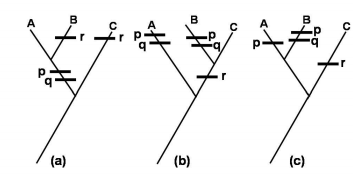 Multiple Choice Questions
Multiple Choice QuestionsWhich of the following statements is NOT true regarding the closer affinity of Archaea to Eukarya than to Bacteria?
Both Archaea and Eukarya lack peptidoglycan in their cell walls.
The initiator amino acid for protein synthesis is methionine in both Archaea and Eukarya.
Histones associated with DNA are absent in both Archaea and Eukarya.
In both Archaea and Eukarya, the RNA polymerase is of several kinds.
An alga having chlorophyll a, floridean starch as storage product and lacking flagellate cells belongs to the class
Phaeophyceae
Chlorophyceae
Rhodophyceae
Xanthophyceae
In the case of amphibians, the dorsal lip cells and their derivatives are called as "Spemann Mangold organizer". Following statements related to the organizer were made:
A. It induces the host's ventral tissues to change their fates to form a neural tube and dorsal mesodermal tissues.
B. It cannot organize the host and donor tissues into a secondary embryo.
C. It does not have the ability to self-differentiate into dorsal mesoderm.
D. It has the ability to initiate the movements of gastrulation.
E. Both β-catenin and Chordin are produced by the organizer.
Which of the above statements are correct?
A and D
D and E
A and E
B and C
Peripatus is an interesting living animal having unjointed legs, nephridia, hemocoel, trachea, dorsal tubular heart, claws, jaws, continuous muscle layers in the body wall. This is considered as a connecting link between
Nematoda and Annelida continuous muscle layers in body wall, unjointed legs and nephridia being nematode characters while hemocoel, trachea and dorsal tubular heart being annelid characters.
Annelida and Arthropoda: unjointed legs and nephridia being annelid characters while claws, jaws, hemocoel, trachea and dorsal tubular heart being arthropod characters.
Arthropoda and Mollusca: unjointed legs and nephridia being mollusca characters while claws, jaws, trachea and dorsal tubular heart being arthropod characters.
Nematode and Arthropoda: continuous muscle layers, unjointed legs and nephridia being nematode characters while claws, jaws, trachea and dorsal tubular heart being arthropod characters.
The following schematic diagram represents secondary growth in the angiosperms.

Based on the above scheme, which of the following options represents the correct identity of cambia labelled as A, B, C, and D.
A - Inter-fascicular; B - Fascicular; C - Vascular; D - Cork
A - Fascicular; B - Inter-fascicular; C - Vascular; D - cork
A - Cork; B - Inter-fascicular; C - Fascicular; D - Vascular
A - Cork; B - Fascicular; C - Inter-fascicular; D - Vascular
The table below lists the major fungal groups and their characteristics:
| Fungal groups | Characteristics |
| A. Ascomycota | (i) Hyphae aseptate, coenocytic; asexual reproduction by sporangiophores |
| B. Chytrids | (ii) Hyphae aseptate, coenocytic; asexual reproduction by zoospores |
| C. Glomeromycetes | (iii) Hyphae aseptate, coenocytic; no sexual spores |
| D. Zygomycetes | (iv) Hyphae septate or unicellular; asexual reproduction by conidia. |
Which one of the following options represents the appropriate match between the fungal group and their characteristics?
A - (ii); B - (iii); C - (i); D - (iv)
A - (iv); B - (ii); C - (iii); D - (i)
A - (i); B - (iv); C - (iii); D - (ii)
A - (ii); B - (iv); C - (iii); D - (i)
As a biologist, you want to classify three taxa, A, B, and C. You have the information on three traits, p, q, and r. The trait that is ancestral is counted '0' and the trait that is derived is counted as '1'. The distribution of traits found in three taxa is given below
| A | B | C | |
| p | 1 | 1 | 0 |
| q | 1 | 1 | 0 |
| r | 0 | 1 | 1 |
Based on the above table, the following cladograms were drawn:

Based on trait distribution and the principle, select the correct option
Both 'a' and 'b' cladograms are possible
Only 'b' cladogram is possible
Only 'c' cladogram ispossible
Only 'a' cladogram is possible
Given below are some pathogens and diseases of human, animals, and plants.
| A. Bordetella pertussis | (i) Lyme disease of humans |
| B. Tilletia indica | (ii) Grain rot in rice |
| C. Borrelia burgdorferi | (iii) Karnal bunt of wheat |
| D. Anaplasma marginale | (iv) Whooping cough in humans |
| E. Burkholderia glumae | (v) Hemolytic anemia in cattle |
Which one of the following is the correct match between the pathogen and disease caused?
A - (iv); B - (iii); C - (i); D - (v); E - (ii)
A - (iv); B - (v); C - (i); D - (ii); E - (iii)
A - (iii); B - (iv); C - (v); D - (i); E - (ii)
A - (ii); B - (v); C - (i); D - (iii); E - (iv)
Given below are statements pertaining to organisms belonging to three domains of life. Identify the INCORRECT statement
Unlike Bacteria and Eukarya, some Archael membrane lipids contain long-chain hydrocarbon connected to glycerol molecules by ether linkage.
Peptidoglycans are absent in the cell wall of Archaea.
Proteobacteria include many species of bacteriochlorophyll containing, sulphur using photoautotrophs.
Mycoplasm, a group of low GC content gram-positive bacteria that lack a cell wall, belong to the same family as the gram-positive Mycobacteriaceae.
You observed that two species of barnacles species 1 and species 2, occupy upper and lower strata of intertidal rocks, respectively. Only when species 2 was removed by you from the lower strata, species I could occupy both the upper and lower strata. From the choices given below, what would be your inference from these observations?
Upper strata of the intertidal rock is the realized niche of species 1.
Upper strata of the intertidal rock is the fundamental niche of species 1.
Species 1 and species 2 exhibit mutualism.
Species 1 can compete out species 2.
